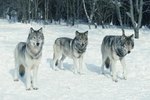
Siberia is known as one of the most formidable habitats on the planet, but this doesn't stop several types of wolves from calling it home. Wolves have lived in Siberia for thousands of years. Special adaptations have resulted in various wolf subspecies that are well-suited to survive this landscape's harsh conditions.
Siberia as a Habitat
Siberia is an extremely large geographic region, covering 8 million square miles. Temperatures are extreme, plummeting far below freezing in winter. Also, in the northernmost latitudes of Siberia, which border the Arctic Circle, the sun only shines half the year. The other half of the year is borne out in perpetual night. But, covering such a big area, there are many different types of landscapes found in Siberia, including forests, tundra, rivers and lakes. Lake Baikal is one of the most species-diverse areas within Siberia. The Siberian taiga, or forest, is one of the largest eco-regions in the world and is home to many species, including wolves. Wolves are well adapted to life within Siberia because of their thick fur coats, keen hunting abilities and willingness to work together in packs when times are tough.
Gray Wolf
The gray wolf (Canis lupus lupus) is the most common wolf in the world, including Siberia. Gray wolves vary in size, weighing anywhere from 70 to 130 pounds, reaching lengths of 3 to 5 feet including the tail, and standing over 3 feet tall at the shoulder. European gray wolves are similar to North American gray wolves but with shorter, denser fur. Gray wolves are actively hunted in Russia because they are not listed as endangered and are a nuisance in populated areas because of their willingness to kill livestock.
Tundra Wolf
The tundra has much less diversity in wildlife than other regions of Siberia. Small rodents such as lemmings and voles, fish, as well as birds like geese and ducks are typical prey for the tundra wolf (Canis lupus albus). Packs can bring down the tundra's largest animal -- the reindeer. Tundra wolves are spread through northern Europe and Asia, into the Arctic. They have been hunted on the islands north of Siberia to the point of near total annihilation, but the subspecies is still represented there. The tundra wolf is a large wolf, reaching lengths of seven feet including the tail and standing about 3 feet tall. They generally weigh between 100 and 125 pounds.
Forest Wolf
Wolves living in the forests and mountains of Siberian taiga follow distinctive behavioral patterns. The forest wolf is shy and will run from domesticated animals, rather than attacking them, for fear of encountering the human that goes along with such beasts. Forest wolves move in packs and are friendly among pack members. They tend to be somewhat smaller than the Canis lupus lupus, and may be black instead of the typical gray.
Steppe Wolf
Steppe wolves (Canis lupus campestris) are most commonly found in the southern parts of Siberia. They form packs to hunt animals such as roe deer, but also often hunt alone. Steppe wolves tend to be more aggressive than other Siberian wolves and fight amongst themselves constantly. The steppe wolf has whitish fur or may be pure white. It is more aggressive, but also more wary of humans than gray wolves. Steppe wolves readily attack livestock and live closer to human habitations than forest wolves. The steppe wolf is endangered because it is legal to hunt and many people kill them to protect their herds.
References
- Geography of Siberia: Antipov, Aleksandr N., ed.
- Notes of an Eastern Siberian Hunter: Cherkassov, A. A.
- Wolves: Behavior, Ecology and Conservation: Mech, David L., ed.; Boitani, Luigi, ed.
- BorealForest.org: Tundra Wolf
- IUCN Canid Specialist Group: 5.2 Grey Wolf -- Canis lupus
- Blue Planet Biomes: Gray Wolf
- Blue Planet Biomes: Taiga
- Siberia: The New Frontier: St. George, George.
Resources
Photo Credits
-
Jupiterimages/Photos.com/Getty Images
Writer Bio
Madeline Masters works as a dog walker and professional writer. In the past she has worked as a fitness columnist, fundraising copywriter and news reporter. Masters won two Pennsylvania Newspaper Association Awards in 2009. She graduated from Elizabethtown College with a Bachelor of Arts in English.




